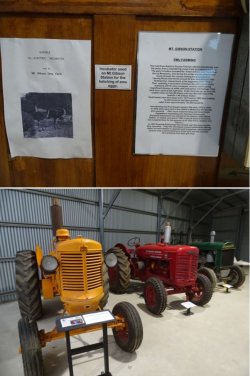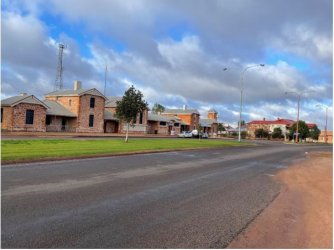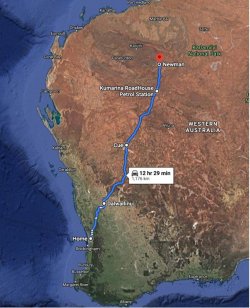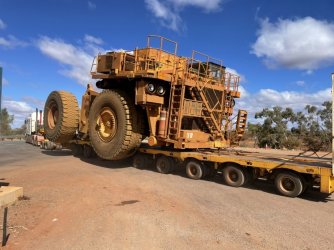You are using an out of date browser. It may not display this or other websites correctly.
You should upgrade or use an alternative browser.
You should upgrade or use an alternative browser.
Covid Revised: Roaming near Rudall River/Karlamilyi National Park
- Thread starter JohnM
- Start date
JohnM
Enthusiast
- Joined
- Jun 7, 2006
- Posts
- 11,811
- Qantas
- LT Gold
VPS
Enthusiast
- Joined
- Apr 2, 2011
- Posts
- 10,473
- Qantas
- LT Gold
- Virgin
- Gold
Of course it wasI’ll consider that a term of endearment.

Daver6
Enthusiast
- Joined
- Dec 31, 2011
- Posts
- 12,172
- Qantas
- Platinum
- Virgin
- Gold
It's almost worth the drive just for that burger.
JohnM
Enthusiast
- Joined
- Jun 7, 2006
- Posts
- 11,811
- Qantas
- LT Gold
Good looking wine...Margaret River or Swan Valley ?
No info on origin. I bought it to souvenir the bottle. The wine was OK.
JohnM
Enthusiast
- Joined
- Jun 7, 2006
- Posts
- 11,811
- Qantas
- LT Gold
JohnM
Enthusiast
- Joined
- Jun 7, 2006
- Posts
- 11,811
- Qantas
- LT Gold
Now back home and resuming transmission.
It turned out to be a good trip, albeit not as remote as was planned/hoped.
The drive out of Perth was in steady rain, that extended a considerable way north. I was nervously watching the radar during the day as I was tenting at Cue and the N edge of the system was looking ominously close to there.
I don’t mind camping in the cold, but in the rain is a totally different matter.
I made a stop at Dalwallinu, at the NE fringe of the Wheatbelt, to mainly check out the information centre about wildflowers. But I also discovered some interesting bits in the centre and a museum in the town, so I spent a bit of time scoping those.

There was this piece of cut and polished Marra Mamba iron ore, a banded iron ore, and a long way from its origin and where it is prolific in the Hamersley Range where I understand that it underpins some sort of mining industry. Quite why it was in a Wheatbelt museum, I do not know. But it was pretty, so I took a picture (through the glass).
The museum was quite interesting and worth a visit. A local early farmer had collected a considerable number of vehicles and implements and lodged them in the museum.


A folding paratrooper’s bicycle from WW2.




It turned out to be a good trip, albeit not as remote as was planned/hoped.
The drive out of Perth was in steady rain, that extended a considerable way north. I was nervously watching the radar during the day as I was tenting at Cue and the N edge of the system was looking ominously close to there.
I don’t mind camping in the cold, but in the rain is a totally different matter.
I made a stop at Dalwallinu, at the NE fringe of the Wheatbelt, to mainly check out the information centre about wildflowers. But I also discovered some interesting bits in the centre and a museum in the town, so I spent a bit of time scoping those.

There was this piece of cut and polished Marra Mamba iron ore, a banded iron ore, and a long way from its origin and where it is prolific in the Hamersley Range where I understand that it underpins some sort of mining industry. Quite why it was in a Wheatbelt museum, I do not know. But it was pretty, so I took a picture (through the glass).
The museum was quite interesting and worth a visit. A local early farmer had collected a considerable number of vehicles and implements and lodged them in the museum.


A folding paratrooper’s bicycle from WW2.




JohnM
Enthusiast
- Joined
- Jun 7, 2006
- Posts
- 11,811
- Qantas
- LT Gold
This was an interesting device.
Back in the day of many agricultural MIS projects, there was an emu farming venture promoted at Mt Gibson Station. This was the incubator for the eggs which, in the absence of dad rolling them over, needed rocking a couple of times a day. The trays moved from about 30 degrees down to the left to the same on the right, and back again.
Like just about all – if not all - of those MIS projects, a failure.



Rabbit traps. When I was about 14 a mate and I would trap rabbits and sell them for pocket money to a firm that supplied butcher shops in Perth. There was a good rabbit warren not far out of the small town where we lived, so we would ride our bikes there after school, set the traps, then go back the next morning before school to collect, kill and gut the catch before lodging them in the cool store where kangaroo shooters also lodged their bounty.
I recall in probably 2nd year high school (year 9), my English teacher (no doubt a city girl fresh out of teachers’ college doing country penance) being amazed by my essay that we were asked to write about things we did in our spare time, or some such.


A 1960s-style grain receival bin. I did a couple of seasons ‘on the bins’, just like this one, during harvest after finishing school and first year uni.


A small section of the modern bin version in the background. Not only are yields greater these days, but there has been a massive shift to crop production and away from wool production.
Canola crops are flowering in northern areas.
And of course, canola was hardly thought of back in those days. Some early dabbling with ‘rape’ met with problems from disease and bitter oil until Canadian plant breeders and agronomists developed ‘sweeter-oil’ and disease-resistant types and rid it of its unfortunate name to originate ‘canola’ (Canola oil - Wikipedia).
The good rains across SW Australia this winter are setting up a bumper cropping season.

Back in the day of many agricultural MIS projects, there was an emu farming venture promoted at Mt Gibson Station. This was the incubator for the eggs which, in the absence of dad rolling them over, needed rocking a couple of times a day. The trays moved from about 30 degrees down to the left to the same on the right, and back again.
Like just about all – if not all - of those MIS projects, a failure.



Rabbit traps. When I was about 14 a mate and I would trap rabbits and sell them for pocket money to a firm that supplied butcher shops in Perth. There was a good rabbit warren not far out of the small town where we lived, so we would ride our bikes there after school, set the traps, then go back the next morning before school to collect, kill and gut the catch before lodging them in the cool store where kangaroo shooters also lodged their bounty.
I recall in probably 2nd year high school (year 9), my English teacher (no doubt a city girl fresh out of teachers’ college doing country penance) being amazed by my essay that we were asked to write about things we did in our spare time, or some such.


A 1960s-style grain receival bin. I did a couple of seasons ‘on the bins’, just like this one, during harvest after finishing school and first year uni.


A small section of the modern bin version in the background. Not only are yields greater these days, but there has been a massive shift to crop production and away from wool production.
Canola crops are flowering in northern areas.
And of course, canola was hardly thought of back in those days. Some early dabbling with ‘rape’ met with problems from disease and bitter oil until Canadian plant breeders and agronomists developed ‘sweeter-oil’ and disease-resistant types and rid it of its unfortunate name to originate ‘canola’ (Canola oil - Wikipedia).
The good rains across SW Australia this winter are setting up a bumper cropping season.

OZDUCK
Established Member
- Joined
- Aug 1, 2010
- Posts
- 4,705
Some nice photos, I must spend a few hours in Dalwallinu one day.
My wife and I were actually at the 'Official Opening ' of the Emu Aboittoir at that Mt Gibson Emu Farm sometime in the 1990's. They were planning to export commercial quantities of tanned Emu skins and intended to claim Govt. subsidies for them - a scheme Customs were administering at that stage. So we went along in as the 'official representatives' to attend the opening and Emu BBQ afterwards.
My wife and I were actually at the 'Official Opening ' of the Emu Aboittoir at that Mt Gibson Emu Farm sometime in the 1990's. They were planning to export commercial quantities of tanned Emu skins and intended to claim Govt. subsidies for them - a scheme Customs were administering at that stage. So we went along in as the 'official representatives' to attend the opening and Emu BBQ afterwards.
- Joined
- Nov 12, 2012
- Posts
- 31,179
- Qantas
- Platinum
- Virgin
- Platinum
- Star Alliance
- Gold
Just think of the amount of gold underneath the weeds ...  . I once weilded my geo hammer around Paynes Find.
. I once weilded my geo hammer around Paynes Find.
JohnM
Enthusiast
- Joined
- Jun 7, 2006
- Posts
- 11,811
- Qantas
- LT Gold
Just think of the amount of gold underneath the weeds .... I once weilded my geo hammer around Paynes Find.
Without success, evidently.
Should have tried botany.
JohnM
Enthusiast
- Joined
- Jun 7, 2006
- Posts
- 11,811
- Qantas
- LT Gold
Overnight at Cue and finally clear of the persistent rain, although there was a sprinkle and a few gusts of wind at about 0200h. A pint of 150 Lashes went down nicely at the Cue pub after the drive, followed by the famous Cue-burger and some Far-Cue red. The Cue-burger is truly excellent, while the Far-Cue red was quite reasonable.
(Edit: Apologies for some duplication here. I had forgotten that I had posted here on the fly; thought it was in the Office View thread.)


Next day, departing Cue and pressing on to Newman. Constant light drizzle much of the way from very low cloud, but nothing showing on the radar. Cleared just prior to a lunch stop at Kumarina Roadhouse.


One thing that characterises Great Northern Highway is the constant road train traffic and regular movement of oversize loads on trucks. The usual preceding and following pilot vehicles apply to wide loads, but once they become super-wide a Main Roads Department escort joins the convoy between the first pilot and the first truck.
The MRD escort vehicle and driver superficially look like police. Blue/red/white lights flashing and they tend to drive down the centre of the road or even in the right lane, to force oncoming traffic off the road. They are really needed only for vehicles without CB radios or not on UHF Channel 40 listening to the comms.
The normal pattern goes like this: the front pilot drives well ahead, and notifies oncoming trucks particularly, and caravans hopefully, that there are, say “2 at 7.5”. In other words, two semis with loads 7.5 m wide are coming. At that width, it’s a large part of the whole road. Oncoming trucks and vehicles on channel will pull over; any that aren’t on channel and fully aware of what is coming at them are forced off by the MRD officer.
As I munched my apple at Kumarina, a convoy of three semis carrying Haulpak chassis, re-entered the road and continued their way S.


(Edit: Apologies for some duplication here. I had forgotten that I had posted here on the fly; thought it was in the Office View thread.)


Next day, departing Cue and pressing on to Newman. Constant light drizzle much of the way from very low cloud, but nothing showing on the radar. Cleared just prior to a lunch stop at Kumarina Roadhouse.


One thing that characterises Great Northern Highway is the constant road train traffic and regular movement of oversize loads on trucks. The usual preceding and following pilot vehicles apply to wide loads, but once they become super-wide a Main Roads Department escort joins the convoy between the first pilot and the first truck.
The MRD escort vehicle and driver superficially look like police. Blue/red/white lights flashing and they tend to drive down the centre of the road or even in the right lane, to force oncoming traffic off the road. They are really needed only for vehicles without CB radios or not on UHF Channel 40 listening to the comms.
The normal pattern goes like this: the front pilot drives well ahead, and notifies oncoming trucks particularly, and caravans hopefully, that there are, say “2 at 7.5”. In other words, two semis with loads 7.5 m wide are coming. At that width, it’s a large part of the whole road. Oncoming trucks and vehicles on channel will pull over; any that aren’t on channel and fully aware of what is coming at them are forced off by the MRD officer.
As I munched my apple at Kumarina, a convoy of three semis carrying Haulpak chassis, re-entered the road and continued their way S.


Last edited:
Read our AFF credit card guides and start earning more points now.
AFF Supporters can remove this and all advertisements
- Joined
- Nov 12, 2012
- Posts
- 31,179
- Qantas
- Platinum
- Virgin
- Platinum
- Star Alliance
- Gold
The normal pattern goes like this: the front pilot drives well ahead, and notifies oncoming trucks particularly, and caravans hopefully, that there are, say “2 at 7.5”. In other words, two semis with loads 7.5 m wide are coming. At that width, it’s a large part of the whole road. Oncoming trucks and vehicles on channel will pull over; any that aren’t on channel and fully aware of what is coming at them are forced off by the MRD officer.
Is there any opportunity to overtake them? ie they pull over every so often, if they can?
JohnM
Enthusiast
- Joined
- Jun 7, 2006
- Posts
- 11,811
- Qantas
- LT Gold
Is there any opportunity to overtake them? ie they pull over every so often, if they can?
Yes, but I didn't actually encounter many really wide ones going my way that I needed to overtake.
That's where it's good to be on UHF Ch40 and let the pilot you are following know that you are on channel. They can then talk to you and bring you around.
Similarly, being on channel is good for letting road trains know that you want to overtake, or to thank the driver if he gives a few flashes of his right indicators to notify the road is clear. $200-300 for a good CB is a worthwhile investment.
The courtesy levels amongst the truckers are exemplary, but they can get pretty p!ssed off with caravans and car drivers who get impatient.
Become an AFF member!
Join Australian Frequent Flyer (AFF) for free and unlock insider tips, exclusive deals, and global meetups with 65,000+ frequent flyers.AFF members can also access our Frequent Flyer Training courses, and upgrade to Fast-track your way to expert traveller status and unlock even more exclusive discounts!

AFF forum abbreviations
Wondering about Y, J or any of the other abbreviations used on our forum?Check out our guide to common AFF acronyms & abbreviations.
Currently Active Users
- A321
- cjd600
- chrisbris
- crosscheck
- Austman
- defurax
- daft009
- Black Duck
- RooFlyer
- tigertraveller
- tassie6
- JMVS
- acestooge
- Quickstatus
- Big John
- auzheng
- Kristian
- Pete98765432
- Trekky1
- muppet
- fkcn
- Katie
- tielec
- Grimace1
- kearvaigskewer
- vhojm
- EmBee
- earlyriser
- Human
- Traveller X
- JohnM
- FlyingFiona
- Marlin118
- Daver6
- ausfox
- Scarlett
- Scash
- BrianQQ
- edshort
- Longtoo
- Rayesfeg
- Chrizztofa
- siwotravels
- jase05
- miles_collector
- RB001
- andye
- vbroucek
- Invisible Monkey
Total: 742 (members: 61, guests: 681)


































